How to Clean Antique Oil Lamps
Learn how to clean your antique oil lamps. To get the full light output from your antique oil lamp you’ll need to clean them.
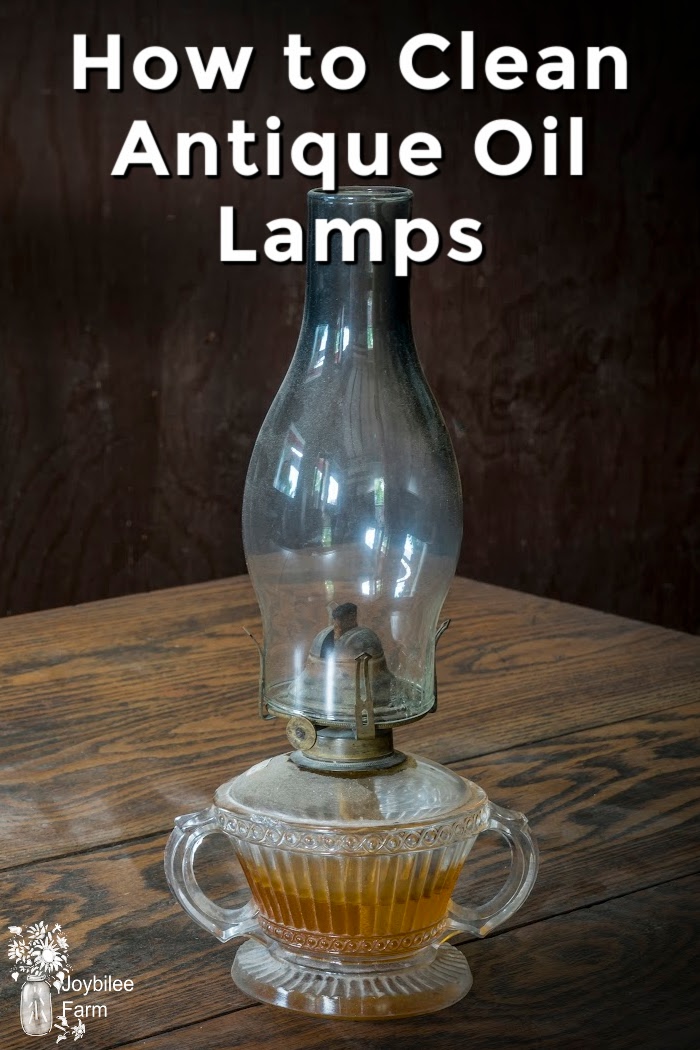
When we bought our first antique oil lamp Mr. Joybilee’s dad scoffed at us. He grew up in 1910 with smoky old kerosene lamps in Scotland and much preferred the convenience and cleanness of electric lighting. He didn’t understand why we would choose to buy antique oil lamps for our home. But I cherished my antique oil lamps and have used them for many years. I use them during power outages and just for ambiance in our home. I switched early from kerosene lamp oil to liquid paraffin lamp oil because paraffin was less smoky and smelly. The odourless fumes can still be toxic though, so allow for adequate ventilation to prevent headaches and chemical sensitivities.
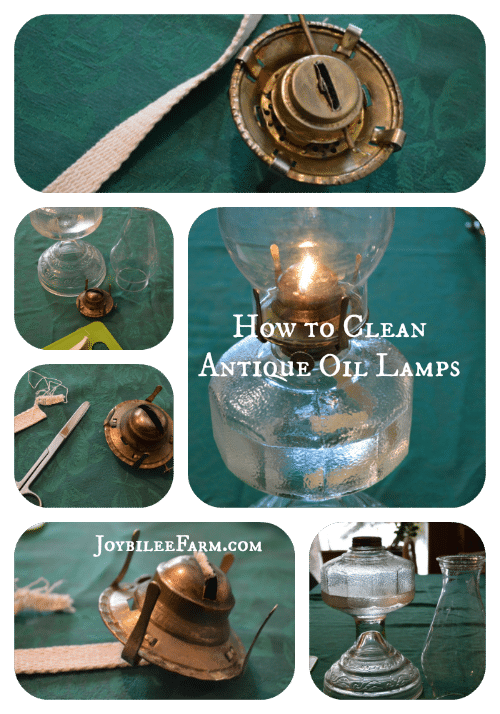
There are three types of antique oil lamps: flat wick, central draught (tubular round wick), and mantle lamps, like Coleman camp lanterns. The most common of these is the flat wick oil lamps. Antique oil lamps give more light than candles with pressurized oil lamps giving off up to 100 lumens of light and flat wick oil lamps giving about 20 to 30 lumens of, light depending on how wide the wick is. For comparison, the average candle gives off 13 lumens while a 60 watt incandescent bulb produces 800 lumens. Oil lamps are used for camping, and when the power goes out. If you live off-grid you’ll use your oil lamps more frequently.
To get the full light output from your antique oil lamps you’ll want to clean them and keep the fuel topped up. But be aware that fuel evaporates from the reservoir of your oil lamps over time, as the wicks are exposed to air. If you are conserving fuel, you may want to keep your lamp reservoirs only partially full, filling them up just before intensive use, during a storm or expected power outage.
Just follow these simple steps and you’ll have your flat wick oil lamps running clean and at high efficiency.
Parts of an antique oil lamp
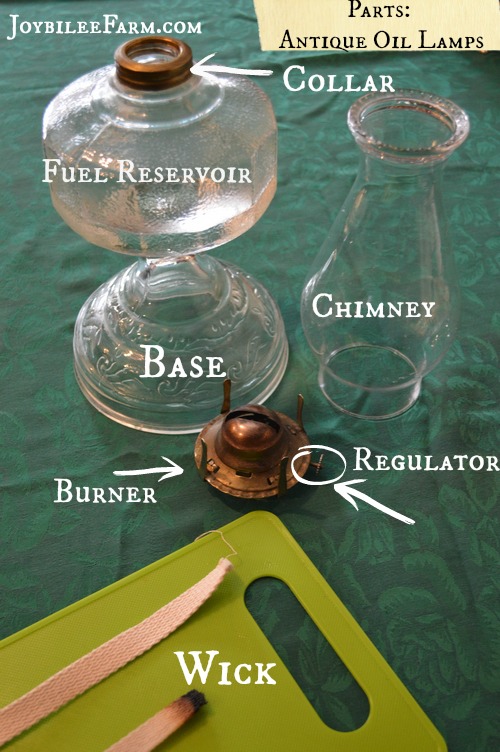
Replacement Parts for antique oil lamps:
Cotton Wicks
Brass Burners
Glass Chimneys
Turn a mason jar into an oil lamp
Lamp Oil
Clean the glass of dust and soot
You don’t need fancy cleaners to clean the glass chimney. Just use a sink of hot soapy water and wipe the inside with an unpaper towel. Be sure to remove all soot and then rinse with hot water. And let it stand to air dry. Your glass chimney will be streakless and clean.
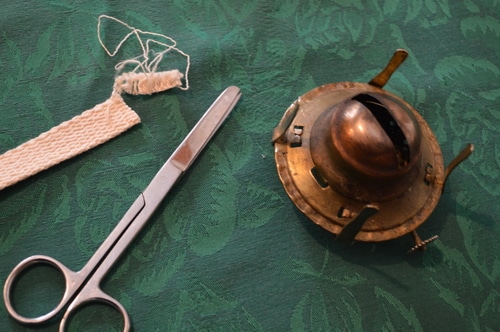
Trim the wick of your antique oil lamp
Remove the wick from the burner.
Clean the burner under running water and brush with a metal brush to get any ash out of the mechanism. You may find carbonized pieces of wick lodged in the burner mechanism. You can remove these by brushing with a toothbrush under running water.
Allow the burner to air dry.
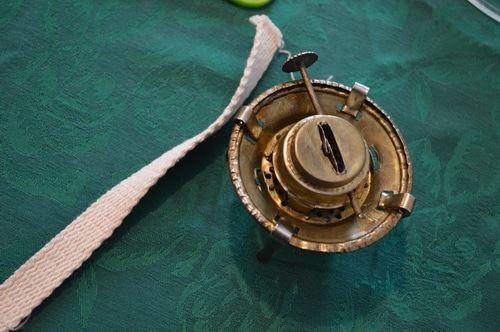
Replace the wick with a fresh wick. Trim the loose threads on the wick with sharp scissors. Slide it into the mechanism at the bottom of the burner and roll the threading screw regulator to raise the wick, just above the burner.

Fill the lamp with oil
When you remove the burner from the lamp the reservoir will be open. Refill the reservoir with lamp oil or liquid paraffin to at least half full.
Do not use cooking oil or olive oil. The heavier oils don’t wick up easily in order to keep the flame supplied with fuel. Learn how to make an olive oil lamp here.
Replacing liquid paraffin or kerosene lamp oil with alternative fuels can result in explosions and wildfires. Only use the recommended fuel for your oil lamp.

Replace the burner on your antique oil lamp
Screw the burner back into place. Allow the wick to saturate in the paraffin oil for an hour before lighting.
Turn up the wick. Light as usual. Turn down the wick using the regulator, until it stops smoking. This is the ideal level of burn for your lamp. As the flame consumes the wick and the oil, you’ll need to adjust the wick as necessary to get a clean, smoke-free burn.
Your newly cleaned antique oil lamp will burn clear, smoke-free, and bright.
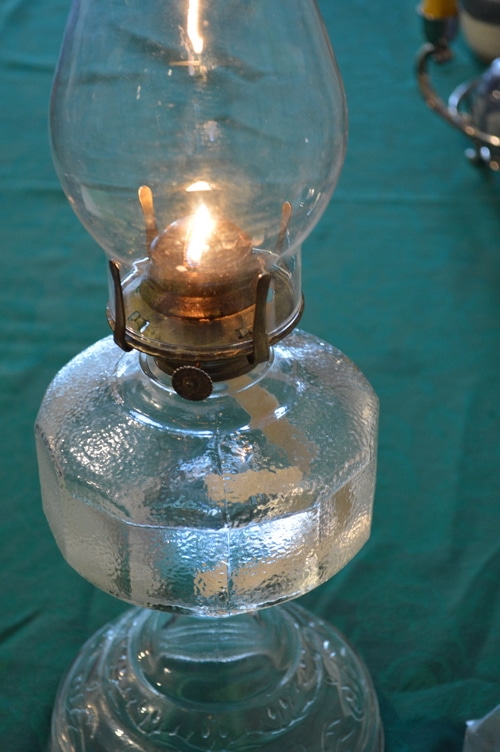



I have an antique lamp my parents bought me several years ago. I need to replace the wick but the burner won’t budge. I tried WD-40 to see if it would loosen and twist off but no luck. any suggestions?
Hi! I just bought an antique glass lamp that was filled with orange paraffin. I dumped it but now i can’t get the orange stains out… any tips?
I grew up in a community in which our religious beliefs had us eschewing modern fashion and conveniences. We dressed plainly, heated with wood and coal, and used oil lamps everywhere on a daily basis. Once a week my mom or grandmother would gather all of the lamps in the house and bring them to the kitchen table. There, they’d trim the wicks, clean the chimneys, and fill the fonts with kerosene. It was a chore to them, but a beautiful ritual to me, and even today, the faint smell and glow of a kerosene lamp says “home”. Funny how the “norm” of today becomes outmoded, as people want “better”, yet even the “better” becomes “not enough” after a while. And why do we want “better” to begin with? Nine times out of ten it isn’t because we’re dissatisfied, it’s because technology wizards and businesses TELL us we are, as they pedal their new products and inventions. I’m not anti-progress really, just saying that we seem to collectively lose some of our humanness in our mad dash pursuit for the latest thing. So many good memories of folks sitting around the table, talking and laughing, or sitting on the porch or in the parlor interacting with each other, not with “gadgets and devices”, with the glow of oil lamps lighting the way.
Beautifully said ❤️
Absolutely, I too, miss those days!
You are so right! I have never fit into the modern world and I’m quite happy with my life. There is so much to say about having a home filled with love and family.
The “collar” on my oil lamp will not unscrew! I’m trying WD-40 today. Are there any other remedies?
Thanks so much!! P.S. I drained the oil out of the lamp sometime ago, so only slight residue remains.
Did you already try soaking it in warm water?
thanks Joybilee from Ontario where we had a power outage last week and i hauled out granpa;s old lamps, they burned but the sludge in the bottom made me worry about fumes so have emptied out and soon ready to fill with paraffin oil, and new wicks, guess that maintenance will be on my list next fall too…steel wool, brushes, nothing worked as well as borax powder and hot water soaking!
The ollar is normally intended to stay affixed to the fuel reservoir. If what you mean is that the burner won’t unscrew from the collar, then a penetrating oil or WD-40 would be reasonable. Somewhere in my head I hear my dad saying oil first and WD if oil doesnt work. If by chance you’ve set the lamp to soak in water (as a personal choice, I would avoid this) and the metal collar has come off the glass, you may as well clean the pieces seperately, then when it’s time to reassemble them, plaster of paris is the traditional material that I’m aware of.
I have the exact oil lamp that you are using in this article. I don’t know anything about it. Could you tell me about it.
I recently acquired two kerosene lamps (circa 1900). They are very different in design, one an elaborate affair, and the other very plain. What they both have in common is that they haven’t been used for many years. When I light them, they burn down very quickly, producing less light than a candle in only a matter of minutes. What do you think they problem might be? I am using newly bought lamp fuel, but still the original wicks. Should I be getting new wicks? Might the problem be that the burner has clogged up?
Try replacing the wicks and cleaning the burner. The wicks may be clogged with dried and oxidated fuel.
How do you get the glass chimney off a metal oil lamp that has the crossed metal bands holding it in place and the metal lever on the side that raises and lowers the chimney?
Does the top Pull up? This video shows how on a Dietz lantern:
https://youtu.be/sT7Qp7ed4T4
How do you remove the collar from the oil lamp? I didn’t see any instructions. Our collar will not move when I try to unscrew it. I didn’t see any pictures for this.
Unless the collar is threaded, it is, in all probability, attached with plaster of paris. Should you wish to replace the plaster, you will need to soak the collar for a few days in white vinegar. It will help dissolve the plaster, and you can lightly twist the collar until it easily lifts from the neck of the lamp. When ready to apply a new collar, or an undamaged old one, you will need to mix up a small amount of plaster of paris and apply it to the neck of the lamp and seat the collar back on the neck, twisting as it is set down. After an hour or so, any residual dried plaster can be easily lifted with a dull knife.
When I was a lad growing up in the West Indies we still had schooners plying their trade up and down the Islands and they taught us to trim the wicks with a slight curve across the end of the wick which gave a clean light and did not smoke up the chimnies..
Hi, I just bought an antique oil lamp that has some stains. It’s an older white glass lamp with the hurricane globe and old white glass lamp shade. The hurricane globe is fine but I’m trying to figure out if there is a way to remove the stains from the white glass. It’s a greenish stain. Not sure if it’s from the oil or what? I’m not sure how to attach a picture to this post, but if there is a way to send you a picture let me know and I’ll send one. Thanks
You could try hydrogen peroxide, rubbing alcohol, or diluted chlorine bleach. (one at a time) If that doesn’t work, make a paste with baking soda, borax, and water and apply that. If it’s just on the surface of the glass one of these might help. If it’s embedded in the glass it may be permanent.
I used simple green & let it soak for about an hour. it came out clean as if it were new .
I use SOS pads to scrub the entire exterior. As long as it is not painted glass. It has just enough abrasive nature that it gets that green residue off.
Good luck
I have an old storm lantern and the oil reservoir has a number of tiny cracks in so does not hold oil for long. Di you know where I might get a replacement made?
I don’t understand how a lamp burns liquid parrafin oil .. do you have to turn the wick up hourly? Will the bottle explode if the wick gets short .. will the fire go inside the bottle .. I don’t understand how this is safe? Help.. bought one .. afraid to use it .. and oh .. do I cut the wick prior to lighting it each time ??
Hi, Monique
Liquid paraffin won’t explode in the same way as kerosene. The paraffin isn’t under pressure. Turn the wick up as necessary and trim it before you light it, yes.
Since the oil evaporates into the air, I don’t use my lamps. I am chemical sensitive plus I would think the fumes would not be healthy for anyone. Is there a safe, non-toxic oil I can use in my antique oil lamps? Thanks.
I’ve got what I believe to be a pretty old oil lamp from a barn sale. The burner appears to be pressed on the oil reservoir and there is a brass cap I think is a vent. I want to take it apart but I’m not sure how to without damaging something. Your picture above may be similar, any tips on how to get this apart? We’re there some lamps that don’t come apart?
I have some lamps that the threads go on the inside and I can’t get them to open also the kerosene has dried up on the inside . I found them in my grandmother & Fathers old smoke house .
You might try soaking them in warm, soapy water overnight. That sometimes loosens them.
I have dealt with kerosene lamps for over 60 years! Our house did not have electricity when we moved here , My job was to clean and fill the lamps every morning.
In later years, I began to buy and sell old lamps. The best cleaner I have found is Dawn Power Dissolver (get the commercial grade) at wholesale house. Spray it on any part that has stains or is dirty. Allow it to stand about a half hour. Rinse and all the crud comes off. Even good for wicks that have become gummy. For attaching collars, use Duram’s water putty. It does a great job. (just did one this AM) You can polish the burners with bits of sos pads held by tweezers.
Thanks for sharing your expertise.
Hi, like Anne we have just bought a Paraffin table lamp only to find when we removed the burner assembly that a hole has been drilled through the bottom of the glass resevoir and it’s brass collar, presumably to convert it to electricity. The collars attaching the glass reservoir to the burner and base are bonded with a hard white substance. Have you any idea what this is? I could just squirt some epoxy / mastic into the hole, but I’ve no idea if it would seal to the white stuff, and would prefer if possible to use the original stuff whatever it is.
Any ideas or suggestions would be very helpful
Some old lamp collars were glued on using plaster.
That would prevent being able to fill the lamp with kerosene.
I have a very old lamp and have a hard residue, i need a brush that has stiff bristles but will bend. This glass flares out at the top and is like a ledge and you can’t reach it. Any brush ideas? I was using a baby bottle brush,but it isnt adequatebecause the handle is too stiff.
Hi Barbara, I am having the same problem with an antique oil lamp that I have. I tried the baby bottle brush also. I was going back through the prior discussions Chris was having with others and found something that might help us both.
This was back in February 2016. Her reply:
Soaking overnight with dawn usually works for me. Other suggestions a strong solution of washing soda, soak overnight. Goo-gone — a commercial product that lifts waxy build up.
Hopes this works.
Monica
Amazing! Soaking in Dawn, a little bit of water and a bottle brush works!
Monica
I have found the best way to clean the residue out of old lamps is with carburetor cleaner (acetone). It works amazingly well. Just be sure to do it outside and dispose of the liquid properly (evaporation works well). Also, the pressurized cans that the carburetor comes in really washes away the residue.
Hope that helps
Acetone worked like a charm to take the stain out from my mother’s blue lamp oil. Thank you!
I wonder if using Dawn dish detergent and some small stones that you use for fish tanks sloshed around might serve as an abrasive…?
Hi! My grandmother gave me her late husbands, his late grandmother’s old oil lamp, (real turn of the century, I know). I bought new oil for the lamp, and a new wick, I took out the old one but I still need to clean the metal (?) parts (how can i clean that?) and what should I do with left over lamp oil? (It’s red) and if should have to get rid of it, then how? Thank you!
I bought an old oil lamp yesterday from an antique store as a Christmas gift for a family member. It came as an electric lamp and I want to convert it back to kerosene but I cannot unscrew the collar. Any suggestions would be greatly appreciated !!
WD 40 might help. Hot water?
Hi
I have a vintage oil lamp from the early 1900s. It has quite a lot of metalwork –as in the base, around the central part where there is a key for moving the wick and an unusual top like an umbrella (with an opening for the glass top). The metal is in need of cleaning with quite a bit of rust. Any suggestions as to cleaning it please?
Many thanks
Christine
You can remove rust with salt and vinegar and fine steel wool. Make a paste with the salt, using just enough vinegar to make it spreadable. Let it sit in the paste for half an hour and then scrub it off with the fine steel wool. Repeat as necessary. Then I would give it a coat of beeswax- walnut oil (try 1 part beeswax to 3 parts oil). That will protect it from rust.
My Eagle oil lamp does not appear to have collar, so I cannot figure out how to remove the burner to fill it. Any help would be appreciated. Thank you
I had to open mine at the base of the burner,not where you would think to open it like a jar lid. . I could not open it at the ring.
Every lamp is different. I’m glad you figured it out.
I have an Aladdin oil lamp and been unable to free its oil-fill cover / screw on cap. A few years ago I applied too much pressure to one and broke the glass neck under the cover so that was a lesson learned. I haven’t soaked it but did spray some vinegar, some penetrating oil and so far no luck.
Appears to me metal and not brass. Any experience with that?
Aladdin lamps are a different breed where the fuel is held under pressure. Your best bet would be to contact Lehman’s. They have a lot expertise in Aladdin lamps. I’m sure they could direct you to where to find help. https://www.lehmans.com/category/lamp-parts/a
Hi Chris
We have an old lamp with a thick brown waxy buildup on the inside, tried the dawn, naphtha, varsol, nothing seems to touch it or soften it up, ever have this problem??
Curtis Beech
Greenwood
Soaking overnight with dawn usually works for me. Other suggestions a strong solution of washing soda, soak overnight. Goo-gone — a commercial product that lifts waxy build up.
I sprayed my Eagle lamp with WD-40 where it screws onto the glass base and let it sit for a short while and it easily screwed off! Hope this works for those of you out there still having problems.
I have this lamp. I can’t get the burner to come loose from the glass. I have sprayed with penetrating oil and it has not worked. Any suggestions?
Have you tried soaking it in warm water with Dawn dishwashing liquid. The lamp oil, when it evaporates can leave a gummy residue behind. I’ve found Dawn to be effective in dissolving that. If Dawn doesn’t work (needs to be that brand) There may be a stronger cleaner, but that usually works for me.
great information here but i have antique lamps that have stained fuel reservoirs and was wondering if there is a way to clean them .. any ideas would be helpful
thanks
Have you already tried Dawn dishwashing liquid. I would try that first. Squirt some in add hot tap water and let it sit overnight. Then brush with a bottle brush. If that doesn’t work then try some baking soda and vinegar in the kitchen sink. But often the Dawn works great. It’s important in this respect to use the name brand. Other dishsoaps don’t have the same chemicals as Dawn.
Do you know the story behind your lamp. I have the exact same one but in green glass. If you have any info, I’d love to hear it. Thank you!
No I’m afraid I don’t. I bought mine at the antique mall in Fort Langley, BC, Canada in the early 1980s. They said it was an antique rather than a reproduction.
My Father-in-law, who was in his late 70s at the time, was askance that I would actually want a kerosene lamp. He grew up with them and remembered the soot on the ceilings and the toxic fumes, and having to clean them once a week.
It’s a tea lamp looks rustedi have a. Karen Anne no 1 tea lamp purple
Thank you Chris. I have several antique oil lamps that I need to clean up and get ready for the spring storms we have in TN.
Thanks for the tutorial. I have several large and mini lamps that I need to clean this spring.